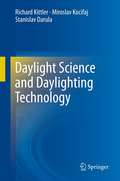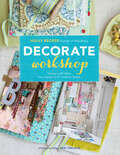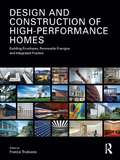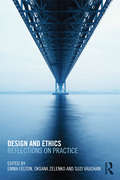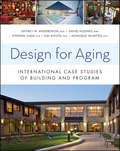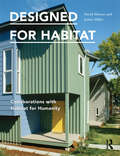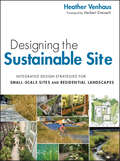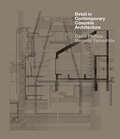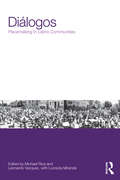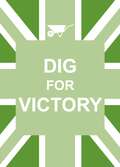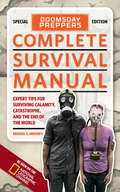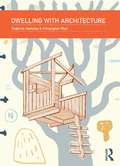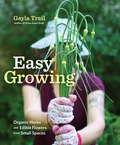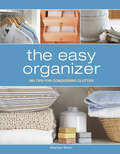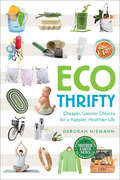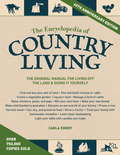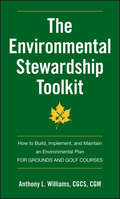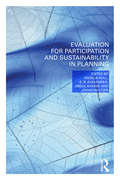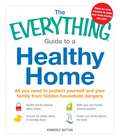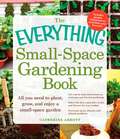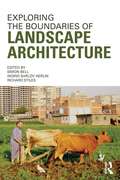- Table View
- List View
Daylight Science and Daylighting Technology
by Miroslav Kocifaj Richard Kittler Stanislav DarulaSunlight profoundly influences the Earth's atmosphere and biosphere. Nature fuels the evolution of all living things, their visual systems, and the manner in which they adapt, accommodate, and habituate. Sun luminance measurements serve as data to calculate typical changes in the daily, monthly, and annual variability characteristics of daylight. Climate-based sky luminance patterns are used as models in predicting daylighting calculation and computer programs applied in architecture and building design. Historically, daylight science and daylighting technology has prioritized photometric methods of measurements, calculation, and graphical tools aimed at predicting or evaluating the daylighting of architectural design alternatives. However, due to a heightened awareness of general health and well-being, sunlight exposure and freedom from visual discomfort while undertaking visual tasks are now equally prioritized. Therefore, in order to assure optimal environmental quality, daylighting technology must be based on sound science. Daylight Science and Daylighting Technology, by Richard Kittler, Miroslav Kocifaj, and Stanislav Darula, sketches the entire evolution of daylight science from atmospheric science through apt visual workplace psychophysics.
Decorate Workshop: Design and Style Your Space in 8 Creative Steps
by Holly BeckerA companion to Decorate, the international bestseller, this interactive guide takes readers step by step through the decorating process of beloved stylist and blogger Holly Becker. In Decorate Notebook, Becker shares her personal design philosophy and explains how to carry a vision into a finished room, from the early paint swatches to the final accents. Readers will learn how to identify their style, create mood boards, outline a schedule and budget, source materials, and start decorating! Filled with expert tips, important checklists, blank space for making lists and plans, and 250 photographs of gorgeous interiors, this is an essential planner for home decorators whatever their budget.
Design and Construction of High-Performance Homes: Building Envelopes, Renewable Energies and Integrated Practice
by Franca TrubianoBoth professionals and students are increasingly committed to achieving high-performance metrics in the design, construction and operation of residential buildings. This book responds to this demand by offering a comprehensive guide which features: architectural innovations in building skin technologies which make lighter more transparent buildings high performing; energy-free architectural design principles and advances in building-integrated photovoltaics; essential engineering principles, controls and approaches to simulation for achieving net zero; the advantages of integrated design in residential construction and the challenges and opportunities it engenders; detailed case studies of innovative homes which have incorporated low-energy design solutions, new materials, alternative building assemblies, digital fabrication, integrated engineering systems and operational controls. Divided into four parts, the book discusses the requisite AEC (Architecture, Engineering and Construction) knowledge needed when building a high-performance home. It also communicates this information across four case studies, which provide the reader with a thorough overview of all aspects to be considered in the design and construction of sustainable homes. With contributions from experts in the field, the book provides a well-rounded and multi-faceted approach. This book is essential reading for students and professionals in design, architecture, engineering (civil, mechanical and electrical), construction and energy management.
Design and Ethics: Reflections on Practice
by Emma Felton Oksana Zelenko Suzi VaughanThe value of design for contributing to environmental solutions and a sustainable future is increasingly recognised. It spans many spheres of everyday life, and the ethical dimension of design practice that considers environmental, social and economic sustainability is compelling. Approaches to design recognise design as a practice that can transform human experience and understanding, expanding its role beyond stylistic enhancement. The traditional roles of design, designer and designed object are therefore redefined through new understanding of the relationship between the material and immaterial aspects of design where the design product and the design process are embodiments of ideas, values and beliefs. This multi-disciplinary approach considers how to create design which is at once aesthetically pleasing and also ethically considered, with contributions from fields as diverse as architecture, fashion, urban design and philosophy. The authors also address how to teach design based subjects while instilling a desire in the student to develop ethical work practices, both inside and outside the studio.
Design for Aging
by Jeffrey Anderzhon Faia David Hughes Riba Stephen Judd Emi Kiyota Monique Wintjies B. O. T.Architecture/Interior Design An in-depth look at the most innovative aged care facilities today With the world's population aging at a rapid pace, there is a growing need for new ways to provide residential care for older people. Design for Aging explores some of the most successful examples of elderly housing today, focusing on integrating architectural considerations within an unwavering people-driven approach. Written by an international team of experts in aged care design, the book brings together twenty-six case studies from around the world, including Australia, Denmark, England, Japan, the Netherlands, Sweden, and the United States. The authors describe how each scheme has succeeded in addressing the needs of its residents regardless of wide variations in design, geography, cultural factors, medical needs, capital cost, and other factors. Clear, well-documented information for each facility includes: Building descriptions and project data, and how the overall design fits within a geographical location The type of community, including number of residents, ethnicity, and specific conditions such as dementia How to apply universal design principles in different political, social, and regulatory contexts How to create a sense of belonging and well-being for residents while building strong connections with the community at large What makes a facility able to attract and retain high-quality caregivers Environmental sustainability issues, plus indoor and outdoor spaces Architects and interior designers as well as facility owners and caregivers will find Design for Aging an inspiring and practical guide on how to navigate the many factors involved in creating good designs for aged care environments.
Designed for Habitat: Collaborations with Habitat for Humanity
by David Hinson Justin MillerIf you're looking for ways to give back to your community, then this book, the first to profile thirteen projects designed and built by architects and Habitat for Humanity, will help. Detailed plans, sections, and photographs show you how these projects came about, the strategies used by each team to approach the design and construction process, and the obstacles they overcame to realize a successful outcome. The lessons and insights, presented here will aid you, whether you're an architect, architecture student, Habitat affiliate leader, or an affordable housing advocate. Located all across the United States, these projects represent the full spectrum of Habitat for Humanity affiliates, from large urban affiliates to small rural programs. These cases illustrate a broad range of innovative approaches to energy performance, alternative construction strategies, and responses to site context. And each house demonstrates that design quality need not fall victim to the rigorous imperatives of cost, delivery, and financing.
Designing the Sustainable Site
by Heather VenhausThe full-color, practical guide to designing sustainable residential landscapes and small-scale sites "Going green" is no longer a choice; it's a necessity. Developed landscapes have played a significant role in exacerbating the environmental and social problems that threaten humanity; however, they can also be part of the solution. Designing the Sustainable Site: Integrated Design Strategies for Small-Scale Sites and Residential Landscapes gives site designers and landscape architects the tools and information they need to become a driving force in the quest for sustainability. Advocating a regenerative design approach in which built landscapes sustain and restore vital ecological functions, this book guides readers through a design process for new and redeveloped sites that not only minimizes damage to the environment but also actively helps to repair it. Designing the Sustainable Site: Assists designers in identifying and incorporating sustainable practices that have the greatest positive impact on both the project and the surrounding community, within a regional context Uses photographs, sketches, and case studies to provide a comprehensive look at successful green landscape design Illustrates how sustainable practices are relevant and applicable to projects of any size or budget Demonstrates how built environments can protect and restore ecosystem services Explains the multiple and far-reaching benefits that sustainable design solutions can provide Assists project teams in fulfilling credit requirements of green building assessment tools, such as LEED, BREEAM, or SITES With attention to six global environmental challenges-including air pollution, urban flooding and water pollution, water shortages, invasive species, and loss of biodiversity-along with guidance on how to meet these challenges, Designing the Sustainable Site is a practical design manual for sustainable alternatives to small-scale site and residential landscape design.
Detail in Contemporary Concrete Architecture (Detail)
by David Phillips Megumi YamashitaDetail in Contemporary Concrete Architecture provides analysis of both the technical and the aesthetic importance of details in modern concrete architecture. Featuring the work of renowned architects from around the world, this book presents 49 of the most recently completed and influential concrete designs for both residential and commercial architecture.The projects are presented in clear and concise layouts over four pages. All of the drawings are styled consistently and presented at standard architectural scales to allow for easy comparison. Each project is presented with colour photographs, site plans and sections and elevations, as well as numerous construction details. There is also descriptive text, detailed captions and in-depth information for each project. A bonus CD-ROM contains drawings from the book, in both EPS and DWG (generic CAD) formats.
Diálogos: Placemaking in Latino Communities
by Michael Rios Leonardo Vazquez Lucrezia MirandaLatinos are one of the largest and fastest growing social groups in the United States, and their increased presence is profoundly shaping the character of urban, suburban, and rural places. This is a response to these developments and is the first book written for readers seeking to learn about, engage and plan with Latino communities. It considers how placemaking in marginalized communities sheds light on, and can inform, community-building practices of professionals and place dwellers alike. Diálogos: Placemaking in Latino Communities will help readers better understand the conflicts and challenges inherent in placemaking, and to make effective and sustainable choices for practice in an increasingly multi-ethnic world. The essays explore three aspects of place: the appropriation and territorialization of the built environment, the claiming of rights through collective action, and a sense of belonging through civic participation. The authors illustrate their ideas through case studies and explain the implications of their work for placemaking practice. A consistent theme about planning and design practice in Latino communities emerges throughout the book: placemaking happens with or without professional planners and designers. All of the essays in Diálogos demonstrate the need to not only imagine, build, and make places with local communities, but also to re-imagine how we practice democracy inclusive of cross-cultural exchange, understanding, and respect. This will require educators, students, and working professionals to incorporate the knowledge and skills of cultural competency into their everyday practices.
Dig For Victory
by Summersdale PublishersThe World War Two slogan is still pertinent in these thrifty times as more people than ever are turning to self-sufficiency and growing their own fruit and vegetables. This little compendium is packed with tips and hints on how to make the most of your garden along with witty quotations to help you dig for victory.
Dig For Victory
by Summersdale PublishersThe World War Two slogan is still pertinent in these thrifty times as more people than ever are turning to self-sufficiency and growing their own fruit and vegetables. This little compendium is packed with tips and hints on how to make the most of your garden along with witty quotations to help you dig for victory.
The Domestic Space Reader
by Chiara Briganti Kathy MezeiTune in to HGTV, visit your local bookstore's magazine section, or flip to the 'Homes' section of your weekend newspaper, and it becomes clear: domestic spaces play an immense role in our cultural consciousness. The Domestic Space Reader addresses our collective fascination with houses and homes by providing the first comprehensive survey of the concept across time, cultures, and disciplines.This pioneering anthology, which is ideal for students and general readers, features writing by key scholars, thinkers, and writers including Gaston Bachelard, Mary Douglas, Le Corbusier, Homi Bhabha, Henri Lefebvre, Mrs. Beeton, Ma Thanegi, Diana Fuss, Beatriz Colomina, and Edith Wharton. Among the many engaging topics explored are: the impact of domestic technologies on family life; the relationship between religion and the home; nomadic peoples and housing; domestic spaces in art and literature, and the history of the bedroom, the kitchen, and the bathroom. The Domestic Space Reader demonstrates how discussions of domestic spaces can help us better understand our inner lives and challenge our perceptions of life in particular times and places.
Doomsday Preppers Complete Survival Manual
by Michael SweeneyThis custom companion to the blockbuster National Geographic Channel series Doomsday Preppersis filled with how-to illustrations, "Prepper Profiles" of people in the show, and survival tips from preppers themselves. Handy and comprehensive, the manual offers valuable life-saving information to help prepare for the most devastating calamities. Episodes of this highly original show, which debuted in February 2012, explore the lives of otherwise ordinary Americans who are preparing for the end of the world as we know it. Preppers go to extraordinary lengths to plan for any of life's uncertainties, from constructing a home out of shipping containers and stockpiling 50,000 lbs. of food to practicing evacuation drills and hand-to-hand combat. This book is an essential component.
Dwelling with Architecture
by Roderick Kemsley Christopher PlattThe dwelling is the most fundamental building type, nowhere more so than in the open landscape. This book can be read in a number of ways. It is first a book about houses and particularly the theme ‘dwelling and the land’. It examines the poetic and prosaic issues inherent in claiming a piece of the landscape to live on. It could also be seen as a kind of road map, full of both warnings and encouragements for all those involved with, or just interested in, the making of houses. That the domestic realm and the landscape can be vehicles for significant architectural insights is hardly an original observation. However this book seeks to bring the two topics together in a unique way. In exploring a building type that lies on the cusp of what is commonly understood as ‘building’ and ‘architecture’, it asks fundamental questions about what the very nature of architecture is. Who indeed is the architect and what is their role in the process of creating meaningful buildings?
Easy Growing
by Gayla TrailGrowing a handful of herbs and edible flowers adds sparkle to dozens of meals year-round. Fortunately for us, these plants are not fussy. They're simple to grow and will fit into any space you can provide, including a crack in a broken patio stone, the step next to your front door, or a windowsill. In Easy Growing, Gayla Trail--author of Grow Great Grub and creator of the top online gardening community, YouGrowGirl.com--shares the tips, ideas, and know-how you need to raise delicious organic edibles wherever you can squeeze in a planter. Herbs give big rewards with a small amount of work--even the most inexperienced, space-strapped gardener will have success. This handbook includes: * Guidance on choosing the right plants, designing dazzling in-ground gardens and striking edible containers, and growing herbs indoors year-round * Ins and outs of growing fifty different plants and hundreds of varieties, from warm and aromatic Mojito mint to peppery nasturtium flowers, from fruity lemon verbena to exotic cinnamon basil, and more * Handy tricks for winterizing plants and extending the outdoor growing period * Simple recipes for cooking with and preserving your harvest: Herb-Encrusted Goat Cheese; Homegrown Bloody Mary Mix; Lavender Shortbread; Orange, Rosemary, and Honey Ice Cream * Upcycling projects based on reusable materials Perfect for novice gardeners and longtime enthusiasts looking for inspiration, Easy Growing is a fun, power-packed resource for creating a delicious herb garden anywhere.From the Trade Paperback edition.
The Easy Organizer: 365 Tips for Conquering Clutter
by Marilyn BohnSay Goodbye to Clutter Do you feel overwhelmed by the "stuff" in your life? Are you tired of sifting through piles every time you or your family need one particular thing? The Easy Organizer can solve your problems. This book has 365 home organization tips that will simplify the way you organize your home. Each tip is full of quick, to-the-point instructions that will give you immediate results. You'll declutter your life in no time. Inside you'll find creative ideas for how to organize: closets and clothing children's toys and artwork storage areas entryways and mudrooms the kitchen the dining room living areas bedrooms bathrooms linen closets and laundry areas craft and hobby materials Plus the book's time management tips will help you get more done in less time and there's a bonus chapter with twenty-one key organizing concepts. When you apply these concepts to your home on a daily, weekly, or monthly basis, being organized will become a way of life. Let the advice in this book help you create a clutter-free home and life you truly enjoy.
Ecothrifty: Cheaper, Greener Choices for a Happier, Healthier Life (Mother Earth News Books for Wiser Living)
by Deborah NiemannUse it up, wear it out, make it do, or do without--our grandmothers knew the importance of responsible, thrifty choices. But somewhere along the way we lost our way and succumbed to the belief that we can get everything for next to nothing, have it shipped halfway around the world and then, more often than not, just throw it away. This consumer binge is taking its toll. Diet and lifestyle-related illnesses are epidemic, our environment is awash in a sea of plastic, our climate is changing, and the cost of everything is skyrocketing with the price of oil. Are we doomed? No. We can make greener, healthier choices, and we can do it while saving money. Where to start? Ecofrugal is packed with simple, practical ideas and recipes to help you: Make homemade products for cleaning and skin care Grow your own food and cook more from scratch Raise your family without lowering your standards A must-read for anyone who has ever wanted to live a greener life but thought that it would be too expensive, time-consuming, or difficult, this handy, complete guide will show you how small changes can have a huge environmental impact and save you thousands of dollars, all while improving your quality of life. Deborah Niemann is a homesteader, writer, and self-sufficiency expert. The author of Homegrown and Handmade: A Practical Guide to More Self-Reliant Living, she presents extensively on topics including soapmaking, breadbaking, cheesemaking, composting, and homeschooling.
The Encyclopedia of Country Living, 40th Anniversary Edition: The Original Manual for Living off the Land & Doing It Yourself
by Carla EmeryThe essential resource for modern homesteading, growing and preserving foods, and raising chickens, The Encyclopedia of Country Living includes how to cultivate a garden, buy land, bake bread, raise farm animals, make sausage, can peaches, milk a goat, grow herbs, churn butter, build a chicken coop, catch a pig, cook on a wood stove, and much, much more. This comprehensive resource is the most authoritative guide available to a sustainable lifestyle and living off of the land. Carla Emery started writing The Encyclopedia of Country Living in 1969 during the back-to-the-land movement of that time. She continued to add content and refine the information over the years, and the book went from a self-published mimeographed document to a book of 928 pages.This 40th Anniversary Edition reflects the most up-to-date resource information and the most personal version of the book that became Carla Emery's life work. It is the original manual of basic country skills that have proved essential and necessary for people living in the country, the city, and everywhere in between.Carla Emery's The Encyclopedia of Country Living contains 1,000,000 words, 2,000+ recipes, and 1,500+ mail-order sources (for everything she tells you how to do, she also tells you where to get the supplies to do it). This book is so basic, so thorough, so reliable, that it deserves a place in every home.From the Trade Paperback edition.
The Environmental Stewardship Toolkit
by Anthony L. WilliamsA comprehensive, one-stop guide to environmental stewardship for golf courses and grounds This highly practical guide covers the full complement of tools green industry professionals need to create a successful environmental program on golf courses and grounds. Written by a leading golf course superintendent and grounds manager, The Environmental Stewardship Toolkit offers a comprehensive analysis of all relevant issues, including environmental management, resource management, community engagement, and document management. The emphasis throughout is on the development of programs that are both sustainable and practical, combining the protection and renewal of environmental systems with a workable business plan. Regulatory issues as well as concerns of owners, customers, and the community at large are also addressed. Clear, pragmatic, up-to-the-minute coverage includes: Numerous illustrations, photos, and customizable templates and checklists that readers can use in their own projects A system for sorting projects into green, greener, and greenest in order to tailor implementation for different budgets and project complexity An in-depth look at site assessment, water quality and conservation, integrated pest management, and wildlife habitat management Guidance for developing green public relations and communications skills to promote the project in the community Field-tested procedures for building a state-of-the art documentation system for capturing, organizing, and disseminating information A must-read for golf course superintendents, irrigation specialists, turfgrass specialists, and grounds managers, The Environmental Stewardship Toolkit is also useful for landscape architects and designers, grounds owners, developers, builders, contractors, and anyone wishing to be on the cutting edge of sustainability in the green industry.
Evaluation for Participation and Sustainability in Planning
by Angela Hull E. R. Alexander Abdul Khakee Johan WoltjerPlanning evaluation is required to establish the success of planning interventions – both of physical developments and new approaches. Yet this should not be a task undertaken purely by professionals without participation by those affected by the process and outcomes of the projects. This book provides case studies and advice on how to balance conservation with economic growth, the cost effectiveness of plans alongside the effects upon the community and the importance of engaging with all stakeholders involved in a project. Practical aspects of the evaluation process covered include: how evaluation is used in planning introducing new kinds of information or criteria alternative ways of collecting/presenting information how strategic planning objectives are implemented in local practice. International contributors provide empirical studies and cases of application which are of practical value to those involved in the evaluation of planning. The book concludes by offering a new paradigm – a locally oriented, context-specific, participatory and multi-disciplinary approach to planning evaluation.
The Everything Guide to a Healthy Home: All You Need to Protect Yourself and Your Family from Hidden Household Dangers (The Everything Books)
by Kimberly ButtonAccording to the U.S. Environmental Protection Agency, the air in our houses is up to five times more polluted than air outside--so it's clear that our homes have become fundamentally unhealthy places. But there is hope! With this guide, you'll learn the immediate changes that make your home--and your life--healthier and safer by neutralizing the toxins, radiation, and chemicals that threaten the average house.Inside you'll find:Instant-fix checklists that will immediately make your home, workplace, and school saferRoom-by-room explorations of the most common and avoidable threatsSpecial tips designed to protect vulnerable infants, children, and pets With detailed checklists that are ranked by the projected health impact of making the fix, you'll be able to make real, concrete improvements to the health of your home. Whether you make every change or just a targeted few, the decisive steps in this guide will result in a safer, more comfortable, and more livable home for you and your family.
The Everything Small-Space Gardening Book
by Catherine AbbottVine-ripened tomatoes. Succulent squash. Plump cucumbers. Growing vegetables is a rewarding--and cost-effective--way to eat better for less. However, you might think you lack the space necessary to grow a functioning garden. With this guide, however, you'll learn how to maximize your space and grow delicious vegetables and herbs cheaply and efficiently, whether you have a small backyard or just a windowsill! The book includes expert information on:How to align plants for maximum compatibility and organic pest deterrenceBuilding small-space necessities, including self-watering containers and vertical plantersA variety of plans designed to maximize the amount of food generated at several specific price pointsProductive gardening can and should be a reality for you, regardless of the amount of land you own. This book has everything you need to grow fresh produce in any size space, at any time of year!
The Everything Small-Space Gardening Book
by Catherine AbbottVine-ripened tomatoes. Succulent squash. Plump cucumbers. Growing vegetables is a rewarding--and cost-effective--way to eat better for less. However, you might think you lack the space necessary to grow a functioning garden. With this guide, however, you'll learn how to maximize your space and grow delicious vegetables and herbs cheaply and efficiently, whether you have a small backyard or just a windowsill! The book includes expert information on:How to align plants for maximum compatibility and organic pest deterrenceBuilding small-space necessities, including self-watering containers and vertical plantersA variety of plans designed to maximize the amount of food generated at several specific price pointsProductive gardening can and should be a reality for you, regardless of the amount of land you own. This book has everything you need to grow fresh produce in any size space, at any time of year!
The Everything Small-Space Gardening Book
by Catherine AbbottVine-ripened tomatoes. Succulent squash. Plump cucumbers. Growing vegetables is a rewarding--and cost-effective--way to eat better for less. However, you might think you lack the space necessary to grow a functioning garden. With this guide, however, you'll learn how to maximize your space and grow delicious vegetables and herbs cheaply and efficiently, whether you have a small backyard or just a windowsill! The book includes expert information on: How to align plants for maximum compatibility and organic pest deterrence Building small-space necessities, including self-watering containers and vertical planters A variety of plans designed to maximize the amount of food generated at several specific price points Productive gardening can and should be a reality for you, regardless of the amount of land you own. This book has everything you need to grow fresh produce in any size space, at any time of year!
Exploring the Boundaries of Landscape Architecture
by Simon Bell Ingrid Sarlöv Herlin Richard StilesWhat have cultural anthropologists, historical geographers, landscape ecologists and environmental artists got in common? Along with eight other disciplines, from domains as diverse as planning and design, the arts and humanities as well as the social and natural sciences, they are all fields of importance to the theory and practice of landscape architecture. In the context of the EU funded LE:NOTRE Project, carried out under the auspices of ECLAS, the European Council of Landscape Architecture Schools, international experts from a wide range of related fields were asked to reflect, each from their own perspective, on the interface between their discipline and landscape architecture. The resulting insights presented in this book represent an important contribution to the development the discipline of landscape architecture, as well as suggesting new ways in which future collaboration can help to create a greater interdisciplinary richness at a time when the awareness of the importance of the landscape is growing across a wide range of disciplines. Exploring the Boundaries of Landscape Architecture is the first systematic attempt to explore the territory at the boundaries of landscape architecture. It addresses academics, professionals and students, not just from landscape architecture but also from its neighbouring discipline, all of whom will benefit from a better understanding their areas of shared interest and the chance to develop a common language with which to converse.
